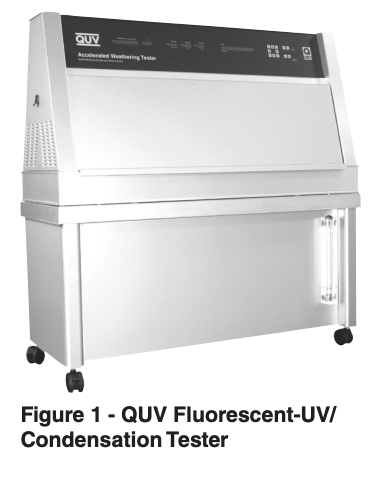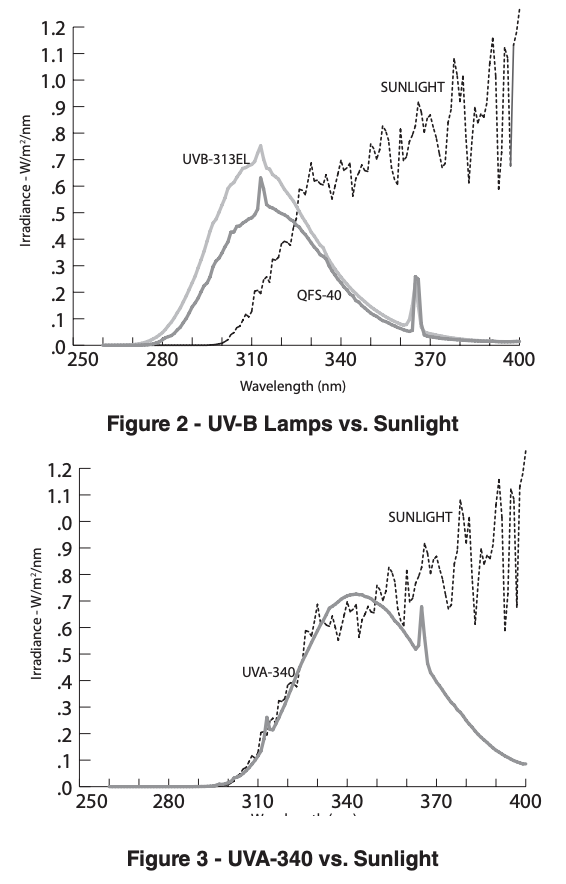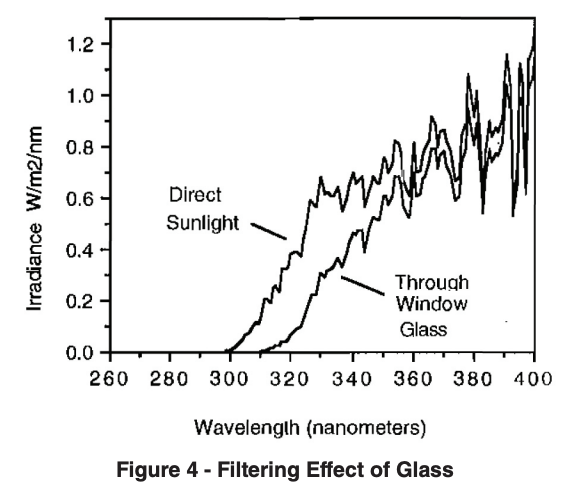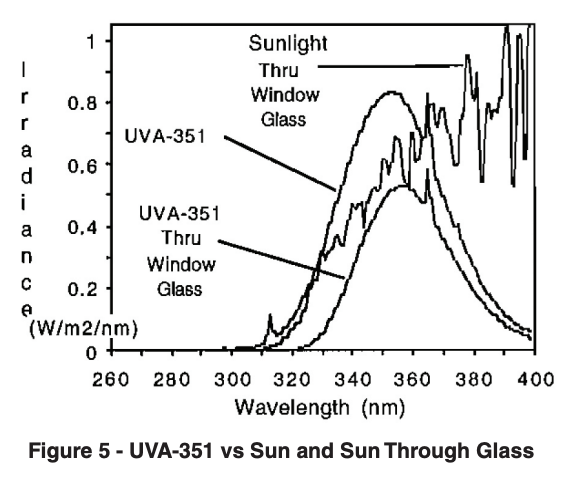LU-8003 Improved UV Light Source Enhances Correlation in Accelerated Weathering
Technical Bulletins
Posted 2023
Last Updated 2023
LU-8003
A new UV-A light source for fluorescent testers improves correlations with actual outdoor testing - although at the expense of some test speed. Its increased accuracy should offset the time penalty for many applications, including both outdoor and behind-glass exposures.
When materials purchasers specify a particular level of weatherability or lightfastness, compound - ers are challenged to provide acceptable durability at a competitive price. Specified tests, especially accelerated aging tests, may seem unrealistically severe. One test parameter often mentioned in this regard is the wavelength spectrum of the light source.
Fluorescent UV testers can now use lamps with different wavelength spectra for different purposes. Users can choose either UV-B lamps, the original and most widely used, or UV-A lamps, which pro - vide improved correlation. The decision, however, involves the inevitable compromise of all accelerated testing: improved correlation usually requires slower tests.

Limited-Spectrum UV Lamps
Over the last several years, accelerated laboratory testing to predict outdoor durability has become commonplace. In large part, the increase in this type of testing was made possible by the introduction of fluorescent-UV/condensation weathering testers such as the QUV® unit shown in Figure 1, recognized by ASTM in 1977 (G-53).
Fast results, easy control of critical variables, ease of operation, and low maintenance have earned rapid acceptance for this type of testing. In addition, fluorescent testers have allowed many small companies that could not justify the expense of arc-type testers to engage in weathering research. Unlike arc testers, fluorescent UV weathering testers have never attempted to reproduce the entire spectral energy distribution of natural sunlight. They operate on the principle that, since the damage to durable materials is caused by short wavelength UV, all a tester needs to do is reproduce these short wavelengths.
Grossman' has reported that this tester has been successful in simulating the effects of sunlight while reproducing only the shortest wavelengths in sunlight, because the shorter the wavelength of light, the greater its ability to cause photochemical damage. The limited spectrum simplifies control of irradiance and eliminates the need for users to waste costly energy producing superfluous visible and IR wavelengths.
For more than 10 years, only one type of UV lamp was used in fluorescent weathering testers, the Westinghouse FS-40 fluores - cent sunlamp. With an output concentrated in the UV-B portion of the UV spectrum (280 to 315 nm), it has been used to test paints, plastics, inks, and textiles.
UV-B Lamp Limitations
Early studies on automotive paint showed that fluorescent UV / condensation testers using FS-40 (UV-B) lamps gave good correlation with Florida weathering. 2 Other tests on paints, plastics, and textiles confirmed this. As large numbers of the testers came into use, however, in a small percentage of cases the UV-B lamp caused anomalies.
Several European laboratories reported that devices using UV-B lamps occasionally failed materials that passed outdoor tests. Some U.S. labs subsequently reported similar findings: on a few polymers, the UV-B lamps occasionally caused unnaturally severe deterioration, typically manifested as unnatural yellowing in white or clear materials. This obviously created correlation prob - lems when lab findings were compared to outdoor results.
The very same short-wavelength UV that gave UV-B lamps much of their acceleration also caused unnatural stresses. Figure 2 shows the spectral energy distribution (SED) of the UV-B lamp compared to sunlight. The UV-B lamp emits a significant amount of UV in wave- lengths shorter than 295 nm. These wavelengths are not found in sunlight, and for polymers sensitive between 280 and 295 nm, the UV-B lamp can be unrealistically severe.
A typical complaint was registered by Dick et. al., 3 who reported that the tester with UV-B lamps gave exposed materials a much yellower appearance than those tested in the field. While it demon - strated a good correlation for paint-finish gloss and material integrity of plastics, they found it did not show good correlation for weathering tests of pigmented plastics.
In comparing weathering of stabilized and unstabi - lized aliphatic urethane acrylate plaques, Gat - echair and Evers 4 found low correlation coefficient, combined with high slope, challenged the ability of UV-B exposures to predict Florida yellowing. And poorer correlation coefficients were obtained at longer UV-B exposure times.
UV-A Lamp Enhanced Correlation
The development of the UVA-340 lamp is a response to these concerns. This lamp still uses only UV light to reproduce the damaging effects of sunlight but does not contain any short wave - lengths below the normal solar cutoff. In a com - parison of sunlight, the UV-B, and the UV-A, Ste - vens 5 found the UV-B lamps showed a far greater disparity with sunlight bemuse of the far greater intensity of their range, while the UV-A lamps were in good agreement with the daylight figures.
Because the UV-A lamp produces only those wavelengths found in natural sunlight, it eliminates any unnatural results from short-wavelength UV. From about 365 nm on down, the UVA-340 lamp gives a good reproduction of natural sunlight. Figure 3 shows SEDs of the UVA-340 compared to the SED of summer sunlight.
Among the first to report the results of using UV-A lamps were McEwan and Simpson, 6 Simpon,7 and Blakely 8 in Europe. Simpson reported that when the UV-B lamp was used, the degree of discrimination obtained between grades of titanium dioxide pigment was very small, a result contrary to natural weathering, and that one pigment grade exhibited anomalous gloss-retention results. Use of UV-A lamps brought an increase in differen - tiation between the grades of titanium dioxide pigments.

Rieger, 9 an early user of UV-A lamps in the United States, reported that Florida results showed differences between interior and exterior formulations, but UV-B made both look bad. With the UV-A, sharp differences between formulations were seen immediately; although it took twice as long, the UV-A gave "the right answers" and his company's pearlescent pigments were approved for use in more than 30 automotive finishes in 1986.
Adams10 found the UV-A helped correlation with dark brown pigments for exterior vinyls. He reported that the regular UV-B lamps gave abnormal results and that a switch to UV-A lamps gave more realistic results and proved to be a good way to screen samples.
Fischer's investigation of correlation parameters is probably the most significant study to date.11 It included seven different fluorescent lamp phosphors (four were different types of UV-A) and two glass types. He found that the UV-A lamps gave significantly better correlation to Florida weathering than the UV-B lamps:
"Excellent correlation to Florida exposure can be achieved for processed (vinyl) films by limiting the emission below the general solar cutoff. The (UV-A) light source also has a favorable effect on Florida correlation for a series of polyurethanebased graphic films.
"The GM58-10 cycle with the (UV-A) source simulates Florida exposure quite well, but some cycle modifications will be needed to predict Arizona results for processed films. It is not surprising that different accelerated cycles will be required for significantly differing climatic regions."
UV-A Interior Testing
Indoor materials are exposed to sunlight filtered through window glass, not direct sunlight. Although common window glass has very little effect on wavelengths above 370 nm, it has a dramatic filtering effect on the short wavelength UV portion of the spectrum (Figure 4). Consequently, use of UV-B lamps with their high-energy shortwavelength UV is inappropriate for behind-glass applications.
In contrast, the UVA-351 lamp has only slightly more UV than sunlight filtered through glass (Figure 5). It can be used to accelerate testing without unnaturally stressing interior materials and is an excellent simulator of sunlight filtered through window glass for indoor or automotive interior testing.


UV-A vs. UV-B
Although the UV-A lamps allow a superior correlation with actual outdoor weathering, UV-B lamps are still used much more widely than UV-A lamps. And there are several sound reasons for continuing to use them:
- Acceptable correlation. For most materials, the UV-B does give very acceptable results. This is especially true for most coatings, particularly those that are moisture sensitive.
- Relativity of results. If one generic family of materials is being tested, UV-B gives good relative-ranking results.
- Speed. For most materials, UV-B accelerates deterioration of materials about twice as much as the UV-A lamp.
One easy way to determine which UV lamp is best for a particular test program is to run a representative group of test specimens under both UV-A and UV-B. If there is only a difference in the rate, but not in the type of deterioration, the UV-B can be used for the fullest advantage in acceleration.
One user reports that his company is now employing both UV-A and UV-B lamps.12 "When we want the real world, we use UV-A. When we do development work, we use the UV-B for a fast answer to see if we are headed in the right direction."
Conclusion
Results from any accelerated weathering test can only indicate relative durability of materials compared to each other - not the absolute number of years materials will last in service. In fact, even outdoor tests are relative.
Camina and Steven,13 for example, tested a group of coatings at six different outdoor exposure sites throughout the world and tried to correlate gloss loss and chalking. They found that, "in general, correlations between natural sites were not good." Correlations between out- doors and accelerated test results are even more difficult.
No matter what sort of accelerated weathering tester is used, there are only a limited number of parameters that can be programmed: UV spectrum, moisture, temperature, and test cycle. The parameters a programmer chooses are, to a certain extent, arbitrary.
Even the most elaborate tester is really just a screening device. The usefulness of accelerated tests is that they can give reliable indications of which material, formulation, or product performs best under specific conditions.
For almost 15 years, UV-B lamps have been used in the fluorescent- UV / condensation testers - to the point that they are practically a standard in the United States for accelerated weathering tests. UV-A lamps operate on the same principle as the older lamps but, because they produce no UV below the solar cut-off of about 295 nm, they can be used to enhance correlation with actual outdoor results. Price for enhanced correlation is usually reduced acceleration.
As Fischer11 concluded, "The use of a light source with a spectral energy distribution more closely matching sunlight does lengthen test times but, in general, gives more reliable results for most materials. Test speed and accuracy are always in direct opposition. Key to accelerated testing is to accelerate but not exceed the stress limits that lead to rank- performance reversals.
References
D. Grossman. "Know Your Enemy: The Weather and How to Reproduce It in the Laboratory,"Journal of Vinyl Technology, Vol. 3, No. 1, pp. 38-47,1981.
G. Grossman. "Correlation of Laboratory to Natural Weathering," Journal of Coating Technology, Vol. 49, No. 633, pp. 45-54, 1977.
J. Dick, M. Chao, D. Garrett Jr., and S. Pogasic. "Weatherability of Pigmented Plastics," SAE Technical Paper Series, No. 850350, 1985.
L. Gatechair and H. Evers 111. "Improving the Weatherability of Radiation-Cured Coatings," Modern Paint & Coatings, April 1986, pp. 38-42.
G. Steven. "Some Measurements of UV- Radiation from Artificial Weathering Machines and Daylight," Paint R.A. Progress Report, No. 7, 1985.
H. McEwan and L. Simpson. "An Evaluation of a Fluorescent UV-Condensation Apparatus for Accelerated Weathering Tests," Tioxide Technical Service Report, No. 9187 GC, 1985.
L. Simpson. "Influence of Titanium Dioxide Pigment on Durability of Paint Films," Tioxide Technical Service Report, No. 9160 GC, 1983.
R. Blakely. "Evaluation of Paint Durability - Natural and Accelerated," Progress in Organic Coatings. Vol. 13, pp. 279-296, 1983.
C. Rieger. Personal communication, 1986.
W. Adams, "Browns for Exterior Vinyl Applications," SPE 42nd ANTEC Proceedings, 1984.
R.M. Fischer. "Accelerated Weathering Test Development with Fluorescent UV-Condensation Devices," SAE Technical Paper Series, No. 841022, 1984.
G. Beebe, Personal communication, 1986.
M. Camina and G. Steven. "Artificial Weathering Test Methods: Gloss and Chalking Changes - An Interim Report," Paint R.A. Progress Report No. 11, 1986.